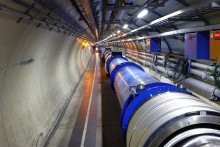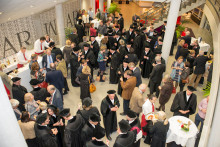Stan Bentvelsen´s lecture, titled 'The Latest Results from CERN', was on the program of the UT´s Week of Inspiration. During it, Bentvelsen explained why there even is an experiment, which uses one third of the world´s supply of helium and needs to be run 24 hours a day, 7 days a week.
40 million collisions per second
This experiment of course relates to the mentioned Large Hadron Collider (LHC), the world´s largest and most powerful particle accelerator, built in 2008. This extraordinary piece of technology consists of 27-kilometers long ring of superconducting magnets, some of which also come from the University of Twente. These magnets, chilled by helium to -271.3°C, allow two beams of particles to travel in opposite directions inside two separate pipes and eventually collide.
The collisions take place inside ATLAS, a special detector as large as the Royal Palace in Amsterdam. There are 40 million collisions per second, but the detector selects about 600 of them, which are saved and later analyzed. Why? 'Once the particles collide, they seize to exist and their mass is liberated as pure energy,' explained Bentvelsen. 'If you give the particles enough energy, you can create new heavier particles by colliding them.' And that is how new particles are discovered.
New particles, new questions
In fact, entire families of particles have been discovered thanks to CERN, including the famous Higgs boson particle. 'We detect the decay particles. Heavy particles decay into light (semi)stable particles, which allows us to calculate the mass of the heavy particle. You can never predict the outcome of the collisions, so we need as many collisions as possible. That´s why we operate the LHC non-stop,' said Bentvelsen. 'Once in a while, we get results that are not in line with what we´d normally expect. That can mean a new particle, such as the Higgs boson, which was officially discovered in 2012.'
However, it seems that the discovery of the Higgs particle brought more questions than answers. 'There are so many things about the Higgs particle that we simply don´t understand. It seems that the current Standard Model isn´t complete,' stated Bentvelsen. 'A number of observations on LHC can´t be explained, and so we want to find what is beyond the Standard Model. LHC might bring an insight into that. It might reveal how the universe evolved and what the dark matter is. 96% of the universe consists of the dark matter, but we don´t know what it is. That might all change. We are only at the beginning.'







